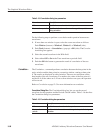
The Graphical Waveform Editor
AWG610 Arbitrary Waveform Generator User Manual
3-69
Do the following steps to perform a correlation math operation between two
waveforms:
1. If more than one window is open, select the source waveform as follows:
Push Window (bottom)!Window1, Window2, or Window3 (side).
2. Push Tools (bottom)!Correlation... (pop-up)!OK (side).
The Correlation dialog box appears.
3. Select the second waveform in the With field.
4. Select either Off or On in the Treat waveform as periodic field.
5. Push the OK side button to generate the result of correlation of the two
waveforms.
The Digital Filter... command applies a digital filter to the whole of the active
window’s waveform and displays the result in another window. If three windows
are open, the operation will not work.
The digital filter implemented in this instrument is composed of n FIR filter and
Kaizer window functions, where n represents the number of delay elements that
composes the filter. You can specify the n as a tap that varies from 3 to 101. The
larger the value of n (number of taps), the greater the filtering capability.
However, filtering will take a longer time to perform as the value of n increases.
Digital Filter Dialog Box. Figure 3–10 shows the Digital Filter dialog box. Table
3–17 describes the digital filter parameters.
Applying the digital filter results in delay by (number of taps – 1)/2. The original
data is regarded as an iterative waveform during calculation. As a result of the
delay due to the filter, the portion around the start of the output waveform is
influenced by the end of the input waveform.
Digital Filter...


















